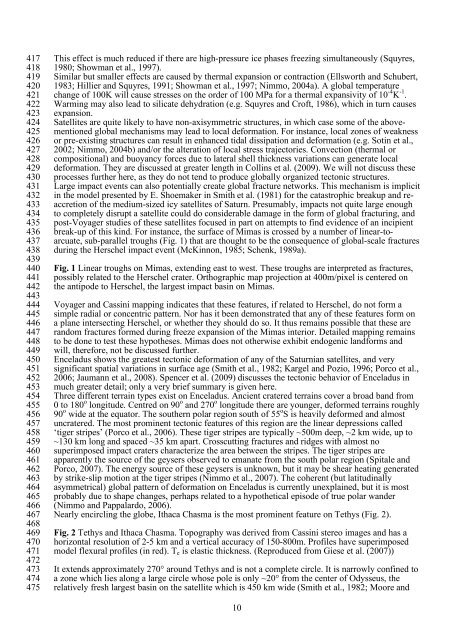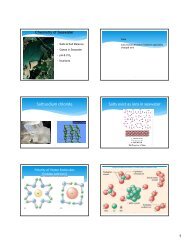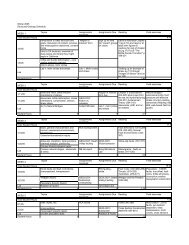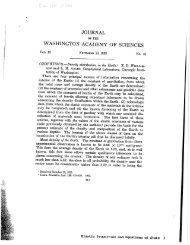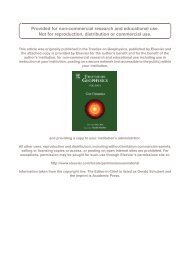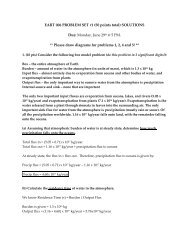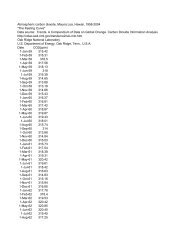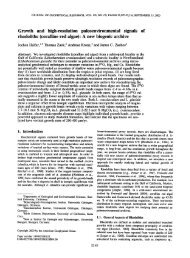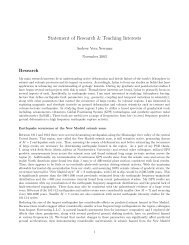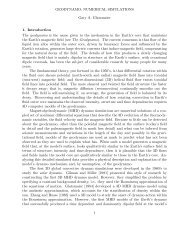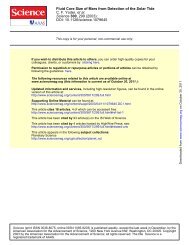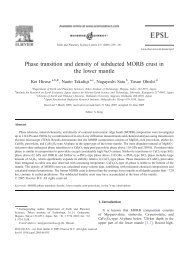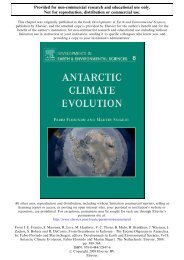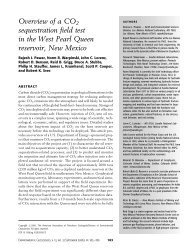Reprint - Earth & Planetary Sciences - University of California, Santa ...
Reprint - Earth & Planetary Sciences - University of California, Santa ...
Reprint - Earth & Planetary Sciences - University of California, Santa ...
Create successful ePaper yourself
Turn your PDF publications into a flip-book with our unique Google optimized e-Paper software.
417 This effect is much reduced if there are high-pressure ice phases freezing simultaneously (Squyres,<br />
418 1980; Showman et al., 1997).<br />
419 Similar but smaller effects are caused by thermal expansion or contraction (Ellsworth and Schubert,<br />
420 1983; Hillier and Squyres, 1991; Showman et al., 1997; Nimmo, 2004a). A global temperature<br />
change <strong>of</strong> 100K will cause stresses on the order <strong>of</strong> 100 MPa for a thermal expansivity <strong>of</strong> 10 -4 K -1 421 .<br />
422 Warming may also lead to silicate dehydration (e.g. Squyres and Cr<strong>of</strong>t, 1986), which in turn causes<br />
423 expansion.<br />
424 Satellites are quite likely to have non-axisymmetric structures, in which case some <strong>of</strong> the above-<br />
425 mentioned global mechanisms may lead to local deformation. For instance, local zones <strong>of</strong> weakness<br />
426 or pre-existing structures can result in enhanced tidal dissipation and deformation (e.g. Sotin et al.,<br />
427 2002; Nimmo, 2004b) and/or the alteration <strong>of</strong> local stress trajectories. Convection (thermal or<br />
428 compositional) and buoyancy forces due to lateral shell thickness variations can generate local<br />
429 deformation. They are discussed at greater length in Collins et al. (2009). We will not discuss these<br />
430 processes further here, as they do not tend to produce globally organized tectonic structures.<br />
431 Large impact events can also potentially create global fracture networks. This mechanism is implicit<br />
432 in the model presented by E. Shoemaker in Smith et al. (1981) for the catastrophic breakup and re-<br />
433 accretion <strong>of</strong> the medium-sized icy satellites <strong>of</strong> Saturn. Presumably, impacts not quite large enough<br />
434 to completely disrupt a satellite could do considerable damage in the form <strong>of</strong> global fracturing, and<br />
435 post-Voyager studies <strong>of</strong> these satellites focused in part on attempts to find evidence <strong>of</strong> an incipient<br />
436 break-up <strong>of</strong> this kind. For instance, the surface <strong>of</strong> Mimas is crossed by a number <strong>of</strong> linear-to-<br />
437<br />
438<br />
439<br />
arcuate, sub-parallel troughs (Fig. 1) that are thought to be the consequence <strong>of</strong> global-scale fractures<br />
during the Herschel impact event (McKinnon, 1985; Schenk, 1989a).<br />
440 Fig. 1 Linear troughs on Mimas, extending east to west. These troughs are interpreted as fractures,<br />
441 possibly related to the Herschel crater. Orthographic map projection at 400m/pixel is centered on<br />
442 the antipode to Herschel, the largest impact basin on Mimas.<br />
443<br />
444 Voyager and Cassini mapping indicates that these features, if related to Herschel, do not form a<br />
445 simple radial or concentric pattern. Nor has it been demonstrated that any <strong>of</strong> these features form on<br />
446 a plane intersecting Herschel, or whether they should do so. It thus remains possible that these are<br />
447 random fractures formed during freeze expansion <strong>of</strong> the Mimas interior. Detailed mapping remains<br />
448 to be done to test these hypotheses. Mimas does not otherwise exhibit endogenic landforms and<br />
449 will, therefore, not be discussed further.<br />
450 Enceladus shows the greatest tectonic deformation <strong>of</strong> any <strong>of</strong> the Saturnian satellites, and very<br />
451 significant spatial variations in surface age (Smith et al., 1982; Kargel and Pozio, 1996; Porco et al.,<br />
452 2006; Jaumann et al., 2008). Spencer et al. (2009) discusses the tectonic behavior <strong>of</strong> Enceladus in<br />
453 much greater detail; only a very brief summary is given here.<br />
454 Three different terrain types exist on Enceladus. Ancient cratered terrains cover a broad band from<br />
0 to 180 o longitude. Centred on 90 o and 270 o 455<br />
longitude there are younger, deformed terrains roughly<br />
90 o wide at the equator. The southern polar region south <strong>of</strong> 55 o 456<br />
S is heavily deformed and almost<br />
457 uncratered. The most prominent tectonic features <strong>of</strong> this region are the linear depressions called<br />
458 ‘tiger stripes’ (Porco et al., 2006). These tiger stripes are typically ~500m deep, ~2 km wide, up to<br />
459<br />
460<br />
~130 km long and spaced ~35 km apart. Crosscutting fractures and ridges with almost no<br />
superimposed impact craters characterize the area between the stripes. The tiger stripes are<br />
461 apparently the source <strong>of</strong> the geysers observed to emanate from the south polar region (Spitale and<br />
462 Porco, 2007). The energy source <strong>of</strong> these geysers is unknown, but it may be shear heating generated<br />
463 by strike-slip motion at the tiger stripes (Nimmo et al., 2007). The coherent (but latitudinally<br />
464 asymmetrical) global pattern <strong>of</strong> deformation on Enceladus is currently unexplained, but it is most<br />
465 probably due to shape changes, perhaps related to a hypothetical episode <strong>of</strong> true polar wander<br />
466 (Nimmo and Pappalardo, 2006).<br />
467<br />
468<br />
Nearly encircling the globe, Ithaca Chasma is the most prominent feature on Tethys (Fig. 2).<br />
469 Fig. 2 Tethys and Ithaca Chasma. Topography was derived from Cassini stereo images and has a<br />
470 horizontal resolution <strong>of</strong> 2-5 km and a vertical accuracy <strong>of</strong> 150-800m. Pr<strong>of</strong>iles have superimposed<br />
471<br />
472<br />
model flexural pr<strong>of</strong>iles (in red). Te is elastic thickness. (Reproduced from Giese et al. (2007))<br />
473 It extends approximately 270° around Tethys and is not a complete circle. It is narrowly confined to<br />
474 a zone which lies along a large circle whose pole is only ~20° from the center <strong>of</strong> Odysseus, the<br />
475<br />
relatively fresh largest basin on the satellite which is 450 km wide (Smith et al., 1982; Moore and<br />
10


